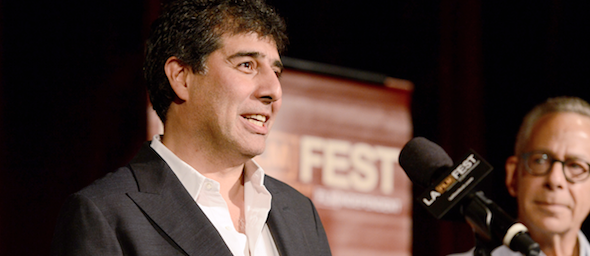The Two Faces of January Director Shares How He Turned a Mystery Novel into a Film Thriller
 Last night, Los Angeles Film Festival goers got to be amongst the first to experience Hossein Amini’s feature film debut, The Two Faces of January, at one of the Festival’s Gala screenings.
Last night, Los Angeles Film Festival goers got to be amongst the first to experience Hossein Amini’s feature film debut, The Two Faces of January, at one of the Festival’s Gala screenings.
The suspenseful thriller stars Viggo Mortensen and Kirsten Dunst as a glamorous American couple who befriends a tour guide (played by Oscar Isaac) in Athens, and entangle him in a web of seduction and murder.
The film was adapted from the novel by Patricia Highsmith, one of Amini’s favorite authors. He has read this particular book every five to six years, since he first read it at University. Amini admitted that he was fascinated by how human beings relate to one another in the context of love and hate–and how those elements could destroy relationships.
Amini has found success as a screenwriter, penning such films as Drive and The Wings of the Dove, but this was his first time sitting in the director’s chair. When the film ended he sat down with Festival Artistic Director David Ansen, going into further detail about how January came to fruition, and what he learned making his debut.
Like most of Highsmith’s novels, January is a mysterious noir, and the film takes on a very Hitchcockian vibe–but Amini says he didn’t really watch the iconic filmmaker’s movies for inspiration. While he admits the book The Truth About Hitchcock certainly played its role in prepping to shoot, it was mainly watching ’60’s European cinema that inspired him. French New Wave and Italian cinema in particular, which he described as “the best film school,” adding that the directors he admires do things “very simply.”
This isn’t the first screenplay adaptation within this genre for Amini, who is excited by the intensity of how characters react under pressure in crime stories. He went on to say that character is much more interesting than plot, even in Highsmith’s novels, which is why he is such a fan of her work. When it comes to adapting and exposing the material to a theatrical audience, there is one important rule: “You can start with drama and go to thriller, but not back to drama.”
Viggo Mortensen plays the film’s lead, and like Amini is very drawn to the complexities of portraying a flawed character. Amini spoke of the film’s funding, and says it was mainly Mortensen’s interest in the role that awarded the film’s $18-plus million dollar budget. “Viggo loves the ugly side of a character. The jealousy, the insecurity…” On directing actors for the first time, he learned “how to say as much as possible with as little as possible. When actors start over-thinking, the spontaneity goes.”
Amini went on to speak of the other elements of the filmmaking process. He found editing among the most challenging, and said on his next film he will be careful not to “jump into the editing room too early.” This was the area in which his insecurities as a filmmaker became exposed, and he felt like it stained the viewing process for him.
An aspiring screenwriter asked how often Amini writes, and he said, “Everyday. Even weekends. But not after 1:00 or 2:00 pm. At 2 o’clock, I think, I should just stop.” He starts writing around 7:30 am, writing every day so not to lose momentum, but has his cut-off time to avoid obsessing over the same one or two lines.
On the subject of score, Amini applauded Alberto Iglesias, and admitted that when they were testing the film on audiences, there was little empathy for Chester (Mortensen’s character), so Amini said, “If nothing else, the music has to love him.”
An honorable mention in the end credits acknowledges the late, great filmmakers Sydney Pollack and Anthony Minghella, and an audience member addressed this, asking of their involvement. Amini revealed that both men were the original producers attached to the project, which spent many years in development and on the shelf. He fondly recalled Minghella’s confidence in him as a director, and that he was willing to take a chance on him.
Chris Lombardi / Festival Blogger